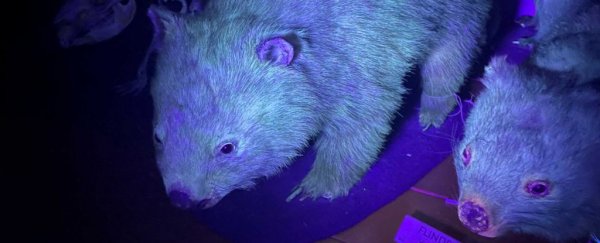First we discovered platypus would look great at a rave, now wombats, bilbies and other marsupials can join the blacklight party - with scientists unexpectedly finding they all glow wonderfully fluorescent greens, blues and pinks beneath UV light.
Over the last few years scientists have found biofluorescence is more common across mammals than we realised - with flying squirrels that glow a bubblegum pink, prompting researchers to see how far back this trait exists in our mammalian heritage by checking out monotremes like the platypus (Ornithorhynchus anatinus) - the most ancient still living mammalian lineage.
Naturally, once the platypus's glow was revealed, other researchers like Western Australian Museum curator of Mammalogy, Kenny Travouillon and biologist Linette Umbrello, started shining UV light on different specimens in the museum's collections.
And so far their findings have been far from disappointing, with revelations of neon wombats and bright-eared bilbies.
"We have only tried it on maybe two dozen mammals, so it wasn't a thorough search," Travouillon told ScienceAlert. "Probably around a third of them did glow."
These included platypus (which they double checked), echidna, bandicoots and bilbies, possums and some bats. The Australian creatures join a host of other living things that biofluoresce, including insects, frogs, fish and fungi.
Biofluorescence occurs when a living thing absorbs high energy radiation such as ultraviolet and then emits light back out at a lower frequency. Many proteins have been identified that can do this in skin or in other animal tissues - including bones and teeth, Australian Museum wildlife forensic scientist Greta Frankham explained to ScienceAlert.
"There are chemical compounds in lots of different animal body parts that do seem to fluoresce, so it's not surprising to find there may be other chemical compounds in other things like fur that fluoresce," Frankham said.
Scientists have isolated some of these molecules and used them for scientific imaging, like the jellyfish's green fluorescent protein.
The exact details of how and why biofluorescence occurs in these mammals is still to be determined. But however it's achieved, it certainly produces some startlingly bright results under UV light, like the ears and tail of this bilby (Macrotis leucura).
https://twitter.com/TravouillonK/status/1323496257986260992?ref_src=twsrc%5Etfw
Bilbies are a nocturnal and endangered desert dwelling species that happens to like eating another animal that glows under UV - scorpions.
https://twitter.com/t_mcachan/status/1330493386097299461?ref_src=twsrc%5Etfw
Wombats and the endangered eastern barred bandicoot (Perameles gunnii) are also nocturnal species. Many of the biofluorescent mammals identified so far are either nocturnal or crepuscular (most active at dawn and dusk), but biofluorescence requires a light source for the glow to then re-emit from and there's less of UV light around at night.
"Perhaps they are able to see much more than we are able to see," Travouillon hypothesised.
"Predators don't seem to glow. I think this is because if predators could be seen, they would lose all chance of catching their prey."
Frankham pointed out however, that many marsupials are nocturnal, so this may not necessarily be a driving factor in evolution of this trait.
While there's now much speculation about why some mammals glow under UV, we've only just realised how wide-spread the phenomenon is. So there's a lot to do before we can glean any answers.
In response to the fuss over the glowing animals on social media, Lund University evolutionary biologist Michael Bok cautioned:
Be careful about applying ecological or visual relevance to this. Many biological materials fluoresce, but the lighting conditions where it is visible to anything are incredibly unnatural. It is extremely implausible that this is a visual signal. pic.twitter.com/rVeYlVVFqu
— Michael Bok (@mikebok) November 26, 2020
Field studies are required to examine if there even are any advantages or disadvantages of this ability within these animals' natural environment - but given how vulnerable many of these Australian species are, it's likely worth checking to see if this trait does impact their ecology or not.
"At this stage, we are all guessing why this is happening, so additional testing will be required to really understand what is going on," Travouillon said. He's planning to test more mammals with different lights and see if there really is a pattern with nocturnal mammals.
